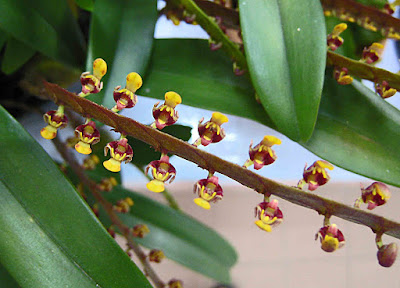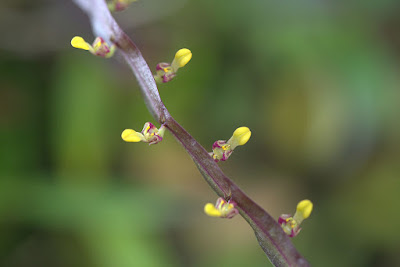Bulbophyllum falcatum is native to Tropical Western Africa. These orchids are found in Guinea, Sierra Leone, Liberia, Cote d'Ivoire, Ghana, Cameroon, as well as in the Congo, Uganda and Principe. Information on the places of growth of this species is few, but there is evidence that in mountainous areas it occurs at an altitude of 300-910 m.
Bulbophyllum falcatum, also called as Sickle-Shaped Leaf Bulbophyllum, Bulbophyllum arnoldianum, Bulbophyllum bakossorum, Bulbophyllum brixhei, Bulbophyllum bufo, Bulbophyllum dahlemense, Bulbophyllum deistelianum, Bulbophyllum falcatum var. bufo, Bulbophyllum falcatum var. velutinum, Bulbophyllum fractiflexum, Bulbophyllum hemirhachis, Bulbophyllum kewense, Bulbophyllum lanuriense, Bulbophyllum leptorrhachis, Bulbophyllum longibulbum, Bulbophyllum lubiense, Bulbophyllum melanorrhachis, Bulbophyllum millenii, Bulbophyllum minutum, Bulbophyllum minutum var. purpureum, Bulbophyllum oxyodon, Bulbophyllum rhizophorae Lindl. 1861, Bulbophyllum seretii, Bulbophyllum simonii, Bulbophyllum solheidii, Bulbophyllum ugandae, Bulbophyllum velutinum, Megaclinium arnoldianum, Megaclinium angustum, Megaclinium brixhei, Megaclinium bufo, Megaclinium deistelianum, Megaclinium endotrachys, Megaclinium falcatum, Megaclinium gentilii, Megaclinium hemirhachis, Megaclinium lanuriense, Megaclinium lasianthum, Megaclinium melanorrhachis, Megaclinium millenii, Megaclinium minutum, Megaclinium minutum var. purpureum, Megaclinium oxyodon, Megaclinium seretii, Megaclinium solheidii, Megaclinium ugandae, Megaclinium velutinum, Phyllorchis bufo, Phyllorchis falcate, Phyllorchis rhizophorae, Phyllorchis velutina, is a species of the genus Bulbophyllum. This species was described by (Lindley)Rchb.f in 1861.
IDENTIFY BULBOPHYLLUM FALCATUM
Bulbophyllum falcatum is native to Tropical west Africa. Plants are found in Guinea, Sierra Leone, Liberia, Côte d'Ivoire, Ghana, Cameroon, as well as in Congo, Uganda and the Princely Island in mountainous regions at 300-910 m.
It is a hot growing, bifoliate epiphyte or occasional lithophyte, usually not exceeding 10 cm in height, with broadly to narrowly ovoid, 2 to 4 angled pseudobulbs of 1.5-5.0 cm high and 1.0-1.7 cm wide at the base, carrying 2 apical, lanceolate or linear leaves. The leaves are 4.0-7.5 cm long and 0.6-2.0 cm wide. It happens that they reach a length of 15 cm.
Sickle-Shaped Leaf Bulbophyllum blooms in winter till spring on a 6 1/4" (to 16 cm) long, spicate inflorescence with a very flattened, strongly undulate, rachis with short-stalked flowers horizontally aligned on either side. The flowers are small, about 1.2 cm long, with an unpleasant smell. The concave, spheroidal shape of the dorsal petal is purple on the outer surface and white with a yellow border on the inside. The very flanked side petals of the external whorl are white with purple spots. The narrow, club-like petals of the inner whorl are white with yellow tips. The inner whorl petals and the lateral outer petals are folded around the base of the flowers. Little, a very pronounced lip, with a tongue-like shape, is purple. The rod is very short and has rounded wings.
BULBOPHYLLUM FALCATUM CARE AND CULTURE
Cultural information should only be used as a guide, and should be to be adapted to suit you. Your physical location; where you grow your plants, how much time you have to devote to their care, and many other factors, will need to be taken into account. Only then can you decide on the cultural methods that best suit you and your plants.
Light:
Bulbophyllum falcatum needs a light level of 12000-20000 lux. The light should be filtered and dispersed, and the plants should not be exposed to direct sunlight. Strong air movement should be ensured all the time.
Temperature:
It is a plant with moderate thermal requirements. Throughout the year, the average day temperature is 23-27 ° C, and the average night temperature is 18-20 ° C, which gives a daily amplitude of 5-7 ° C.
Humidity:
Sickle-Shaped Leaf Bulbophyllum needs a humidity of 85-90% for most of the year, only up to 80% for one month of winter.
Substrate, growing media:
Bulbophyllum falcatum requires excellent drainage and good air circulation around the roots, so they are usually planted into very flat pots or baskets and apply a very loose, quickly drying ground. Different amounts of humectant additives, such as perlite or cut sphagnum moss, can be mixed with a basic material consisting of small to medium sized pieces of pine bark or tree fern fiber.
Repotting:
If the substrate has not decomposed, but the plant has grown out of the container, you can move the plant with the whole root ball to a larger container, without disturbing the roots. If repotting is necessary, it is best to do it when the new roots are already starting to grow, to allow the plant to root as quickly as possible. Plants should, however, be repotted immediately after finding out that the substrate has decomposed.
Watering:
The plants in the active growth phase should be watered frequently, but excellent drainage must be applied and never allow the substrate around the roots to become clumped or soaked. When new growths reach maturity in the autumn, the amount of water should be gradually reduced.
Fertilizer:
In the period of active growth, plants need weekly fertilizing 1/4-1/2 of the recommended fertilizer dose for orchids. You can use a balanced fertilizer, but it is possible to fertilize with increased nitrogen content from spring to mid-summer, and with increased phosphorus content in late summer and autumn.
Rest period:
In winter, the amount of water supplied should be slightly reduced and the plants should be allowed to lightly dry between waterings. However, these plants should never be dried. In winter, when watering plants is limited, fertilization should also be reduced.















COMMENTS